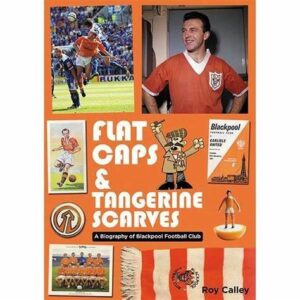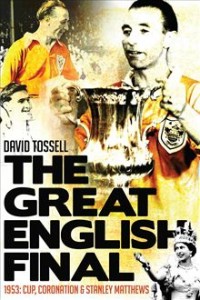Book Review: Flat Caps & Tangerine Scarves – A biography of Blackpool Football Club by Roy Calley
 A biography tends to be about a person, but Roy Calley a former BBC journalist and author of a range of books, has opted to apply this to his beloved Blackpool FC.
A biography tends to be about a person, but Roy Calley a former BBC journalist and author of a range of books, has opted to apply this to his beloved Blackpool FC.
Roy saw his first Tangerines game in January 1968 when Bristol City were the visitors in the old Second Division. He went on to be the editor of the fanzine View from the Tower in 1990, then having published, Blackpool: A Complete Record, 1887-1992 (with an updated version in 2011) and an e-book, Blackpool’s 1953 FA Cup: Tangerine Wizards. Therefore it’s fair to say he knows a bit about the club from Bloomfield Road and most definitely its ups and downs.
The first thing to say that the authors journalist background is evident in the quality of the writing and research. Calley is able to mix a poetic and lyrical style with fact, also including in some places dreamlike fantasy pieces, but retaining a conversational and at times humorous tone in telling the warts and all story of the Lancashire coastal club.
At 188 pages the book covers, at a breathless pace, nine main chapters which could be argued make up the constituent part of the soul of a club, including, The Beginning The Ground, The Colours, The Managers, The Players, The Successes, The Failures, The Owners and The Supporters.
Given the size of the book and the ground it covers, Calley acknowledges that in the chapters around managers and players, not every supporters favourite will be included, but what he does create is text style which reflects those fan conversations had travelling to games and over pre and post-match pints, where names are banded about as villains and heroes are praised and slaughtered in equal measures.
Of course no book about the Tangerines can be written without discussion of the Oyston family era, which began in 1988 and ended in 2019. It was to be ultimately a turbulent period for the Bloomfield Road club both on and off the pitch and Calley offers a pragmatic view of their involvement and the sacrifice fans made in boycotting the club until Blackpool was free of the Oyston’s. Calley’s last line in The Owners chapter, has particular resonance, not just for Blackpool during that time, but for football in general, in the wake of COVID with games played behind closed doors and the aborted launch of the European Super League: The supporters won the club back. A football club is nothing without its fans and Blackpool fans proved that.
This is undoubtedly a book aimed at the Blackpool faithful and will no doubt be a source of debate for those old enough to remember the 1953 FA Cup Final win, and those younger fans who witnessed the 2010/11 Premier League season only to find themselves watching football in the fourth tier just six years later. However, it has a wider appeal for anybody wanting to get a snapshot of this famous English club and its place in the English game.
(Conker Editions Ltd. April 2021. Paperback 188 pages)
 Queen of Cups is the final instalment of the trilogy that includes,
Queen of Cups is the final instalment of the trilogy that includes,  David Tossell’s book about the 1953 FA Cup Final when Stanley Matthews’ Blackpool beat Bolton 4-3 makes a grandiose but puzzling claim. It says that the “…legendary game continues to occupy a prominent place in English football legend…” (sic) because it has, “…come to represent a Golden Age…” But it doesn’t even leave things at that. Not content with such a mighty claim about the game’s footballing pedigree, it makes wider claims for the match that cannot possibly be substantiated. The raw material for a really good story about football is there all right, but he nearly messes it up by trying to bring in too many different themes. Happily, he is saved by the fact that, finally, the Final delivered.
David Tossell’s book about the 1953 FA Cup Final when Stanley Matthews’ Blackpool beat Bolton 4-3 makes a grandiose but puzzling claim. It says that the “…legendary game continues to occupy a prominent place in English football legend…” (sic) because it has, “…come to represent a Golden Age…” But it doesn’t even leave things at that. Not content with such a mighty claim about the game’s footballing pedigree, it makes wider claims for the match that cannot possibly be substantiated. The raw material for a really good story about football is there all right, but he nearly messes it up by trying to bring in too many different themes. Happily, he is saved by the fact that, finally, the Final delivered.